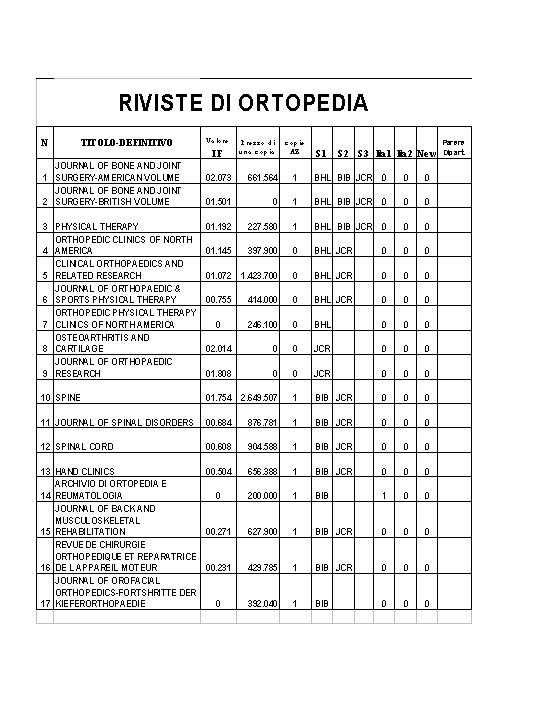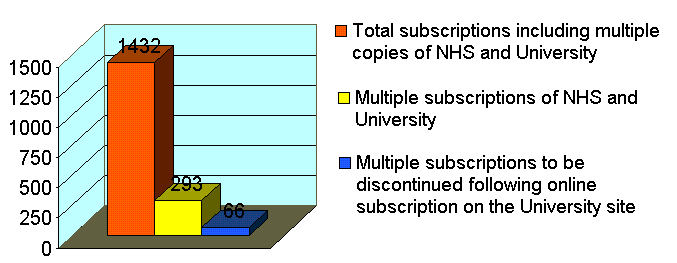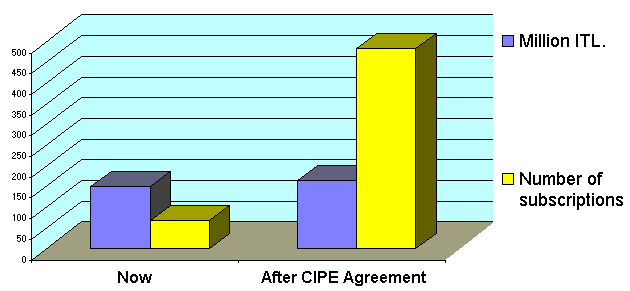
|
|
Introduction
The Central Library of S.Orsola-Malpighi
Hospital in Bologna, following two previous surveys (1, 2), has launched
a project aimed at the planned and co-ordinated management of the subscriptions
to scientific journals of the Hospital (National Health Service) and of
the Faculty of Medicine of the University of Bologna. Soprintendenza per
i beni librari e documentari della Regione Emilia-Romagna takes part to
the project as an external consultant.
31 libraries (12 of the NHS and
19 of the University) are involved, 26 located inside the hospital and
5 in the city centre. Among the libraries at the hospital, there are one
clinical medicine central library of the university, one central -clinical
with some specialised areas - library of the NHS, the remaining libraries
are all specialised ones.
The project wants to:
-
improve the collections of the 31 participating
libraries, both quantitatively and qualitatively
-
reach a satisfactory coverage of all
the disciplines here represented
-
find what 'best ever' titles are not
in the collections
-
reduce multiple subscriptions
-
study terms and conditions for a co-ordinated
acquisition policy between the two institutions.
-
Suggest agreements
for users of the 31 libraries to access the journals by document delivery
(xeroxes) and IT, according to the replies made to a questionnaire
-
rationalize the expenses, particularly
by subscribing to e-journals.
This paper is divided into three sections
A: Titles survey
B: Multiple copies
C: E-journals
Methodology
A: Titles survey
1139 current serials in the 31 libraries
were compared with Brandon Hill List 1999-2000 (BHL) (3,4), Brandon Hill
List Nursing (BHLN) (5) and Journal Citation Report -Science edition 1998
(published 1999) (JCR) -(6); Microsoft Excel was used to this purpose.
The working party evaluated the relevance of each journal against the results
of the comparison. The same criteria were followed for each disciplinary
group:
-
being in Brandon Hill List would bring
the journal in first position
-
journals in Impact Factor JCR would
come second, although the following correctives -aimed at local requirements-
may bring them forward:
-
peer reviewed Italian journals (as from
Ebsco Serials Directory, 14th edition) [#1]
-
Italian journals quoted in JCR, Medline,
Embase, Index Medicus
-
New Italian and foreign journals not
yet in JCR 1998 and/or subscribed in the last three years.
The comparison with BHL and JCR has
shown that some 'best ever' titles were not there: by 'best ever', we mean
those titles that are included in BHL, BHLN and in JCR among top titles
in the Impact Factor of each respective category (see table 1). Both the
1139 present journals and the 'best ever' that should have been there but
were not, underwent an evaluation of usefulness by the teams of professionals
of the NHS and University Departments who marked each title with either
of the following: essential, important, useful, marginal, needless. Each
department was represented by its respective training official; there was
also a representative for the directions that were not among the participating
departments. In order to make decisions about future acquisitions, relevance
and usefulness evaluation were matched in Excel. When the departments had
not expressed any evaluation, the decision was made by the working party.
Two categories were created: TOP
titles and BOTTOM titles. The top category includes journals that were
marked as essential or important for usefulness, whatever their relevance.
The survey also records the top journals which are not present in the collections
but were evaluated as essential (i.e. at the top) and calculates the costs.
The bottom category includes last
quartile journals, ordered in decreasing Impact Factor value. They can
be discontinued in two steps - and savings can be made:
-
step 1 when no correctives are applicable
and scoring needless or marginal for usefulness;
-
step 2 when no correctives are applicable
and scoring from needless to useful.
B: Multiple copies
In order to bring out the existence
of more than one copy of each journal within the 31 participating libraries,
the 1139 titles in the Excel file were completed by the localisation.
C: E-journals
For the time being, publishers consider
NHS and University two separate sites for on-line access and it is therefore
impossible to share one subscription, for copyright and license agreements.
In fact the work of hospital and university staff is integrated, premises
and uses of the libraries shared. The survey tried to monitor, at least,
the multiple printed copies: the suggestion is to discontinue those multiple
subscriptions that also have a print and on-line version. Since the NHS
nucleus does not have multiple copies, the research is limited to the university
libraries for the following categories:
-
Journals that include a 'free-on-line'
access when a print subscription is bought [#2]
-
Blackwell and Elsevier journals subscribed
under a university contract
-
On-line journals at an extra cost of
less than 25% above the regular print subscription
The research outlines the savings deriving
from the discontinuation of extra copies. A questionnaire was administered
to the 31 participating libraries in order to find existing PCs, the Internet/intranet,
fax and Xerox machines and the availability to do document delivery.
The survey on multiple subscriptions
has collected the necessary data to start, wherever possible, an acquisition
policy for on-line journals and to secure one printed copy only. This research
is still going on.
Considering the advantages of consortia
contracts for e-journals, we would suggest NHS Bologna to enter CIPE (Consorzio
Interateneo Periodici Elettronici), so that access to all Elsevier e-journals
package is granted. In this case, it is not so much a matter of savings
but of improving the service with a minimum investment that would multiply
the number of available titles and give readers and librarians the advantages
of hypertexts
Results
A: Titles survey
-
All 29 training officials /representative
(100%) handed in the evaluations of the Departments/ Directions
-
1139 titles, for an overall amount of
ITL 1,702,471,730 ($ 771047 ) were evaluated:
-
91 titles in the bottom category scored
an evaluation of usefulness from needless to marginal or were not evaluated
at all. It is suggested that they are discontinued, thus saving ITL. 72,921,824
($ 33026) ...
-
53 more titles in the same bottom category
scored between needless and useful or were not evaluated altogether. It
is suggested that they are discontinued, in the future, with a further
saving of ITL. 53,453,038 ($ 24208)...
-
The survey also shows the 'best ever'
titles that are not represented in the catalogues:
-
32 BHL, BHLN and JCR journals were outlined
as 'best ever' titles missing from the collection, although they were considered
to be essential; their acquisition involves an expenditure of ITL. 52,237,900
($ 23658)...
B: Multiple copies
-
1432 total subscriptions, including
multiple copies, amounting to ITL.1,702,471,730 ($ 771047)
-
1139 subscriptions (out of 1432 titles)
in one copy, amounting to ITL.1,352,155404 ($ 612389)
-
293 multiple subscriptions, amounting
to ITL. 350,316,324 ($ 158657)
20.6 % of the expenditure needs to be
re-assessed
As we expected, the survey brought
out the multiple copies owned by NHS and University. Also, it is evident
that some titles are present in more than one University library, whereas
there is no similar situation at the NHS libraries. One example is represented
by two very important and often requested journals in 10 copies:1 at the
NHS and 9 at the University.
C: e-journals
In order to evaluate possible savings,
the survey outlined how many multiple subscriptions could be discontinued
at the University while renewing only one Print and free on line subscription:
-
43 titles subscribed by the University
are in more than one copy and on-line: they are journals offered either
as Print and Free on line (10 titles) or as Print and Pay on line at an
extra charge of less than 25% (10 titles). It is possible to discontinue
the multiple print copies of 23 titles and swap them with titles not in
the collection, if they are published by Blackwell and Elsevier which have
a consortium-like contract with University, giving online access to all
the publishers' titles. Print value must be respected.
-
66 multiple print subscriptions in the
University libraries can be discontinued since the corresponding titles
are available on line at the University (see table 3).
-
ITL 88,000,000 ($ 39855) could be saved
accordingly (see Table 2)
30 out of 31 libraries have the necessary
equipment to access on-line journals either on the spot or nearby and they
declare to be available for document delivery if the maximum number of
Xeroxes is pre-defined.
As far as the possibility of NHS
Bologna entering CIPE (Consorzio Interateneo Periodici Elettronici), and
considering an increase of 10% in the cost of Elsevier journals as by now,
the survey calculates the expenses and the number of medical journals that
would become available from the PCs of the NHS (now excluded by the License
Agreement)The results are represented in the following graph (see table
4):
-
ITL 165,000,000 ($ 74728) total foreseeable
expenses for NHS
-
ITL 15,000,000 ($ 6793) (i.e. 10% more)
foreseeable cost for entering CIPE
-
ITL 150,000,000 ($ 67934) spent now
in subscriptions to 68 Elsevier journals
-
68 NHS subscriptions to printed biomedical
journals
-
484 subscriptions to on-line biomedical
journals that can be accessed through CIPE
Discussion and conclusions
The proposal to improve the management
of the resources is going to be put formally forward to the University
and the NHS directions in view of the coming year (2002) subscriptions.
It is articulated as follows:
-
Discontinuation of titles of little
relevance and usefulness
-
New subscriptions to 'best ever' titles
not already in the collections of the university hospital and increase
of subscriptions to on-line journals
-
Discontinuation of the multiple prints
at the university, i.e. one printed copy against its on-line version subscribed
for the university site
-
Agreement on document delivery, aiming
at reducing multiple printed copies -that have no on-line equivalent- in
the collections while granting readers the access to the articles.
Expenditure is made more rational by
the elimination of 'dead-ends' (i.e. bottom titles scoring marginal or
useless) and multiple copies.
The working group is aware of the
difficulties that may arise and that some decisions have to do with the
university and the NHS policies:
-
libraries are scattered and have different
characteristics, organisations and staff
-
some libraries belong to departments
that have independent budgets
-
more than one smaller library is specialised
in the same discipline and this makes multiple subscriptions a difficult
problem.
Notes
[#1] Research study written by Ms
Stefania Scala on EBSCO Serials Directory
[#2] Ebsco quotation for (oppure:
research study on) journal prices for 2001 held by the libraries.
References
1. LOCCHE L., CAVAZZA L., BETTINI
S., Bisturi nella Biblioteca Ospedaliera : tagli dei periodici senza rischi
operatori. Biblioteche Oggi, Settembre 1997, 15(7), pag.24-29
2. CAVAZZA L., LOCCHE L. Towards
an integrated policy of acquisition of serials in the libraries of a hospital.
In: Libraries without limits : changing needs - changing roles : Proceedings
of the 6th European Conference of Medical and Health Libraries,
Utrecht , 22-27 June 1998 / edited by Suzanne Bakker. - Dordrecht : Kluwer,
c1999, pag. 220-223
3. HILL D.R. Brandon/Hill selected
list of print books and journals in allied health . Bull med libr assoc
1999; 87(2):145-169
4. HILL D.R. Brandon/Hill selected
list of print books and journals in allied health . Bull med libr assoc
2000; 88(3):218-233
5. HILL D.R., STICKELL HN.
Brandon/Hill selected list of print nursing books and journals. Nursing
outlook 2000; 48:10-22
6. 1998 JCR, Journal Citation Reports
on microfiche, Science edition, ISI, 1999
Acknowledgments
The authors would like to thank the
teams of the professionals of the NHS and University Departments and the
librarians of the 31 libraries collaborating to the survey. A special thank
to Zeno Orlandi for his cooperation.
Translated by Margherita Spinazzola.
Table 1:
Specimen of evaluation grid for the Departments

Table 2:
Possible savings on University multiple copies following online subscription

Table 3: Possible
reduction of multiple copies in University, following online subscriptions

Table 4: Possible
growth of NHS subscriptions (Online Elsevier) after joining CIPE

[Click on the images to enlarge
them]
|